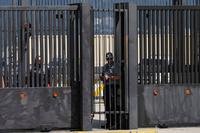The Army has sent at least one "robot dog" armed with an artificial intelligence-enabled gun turret to the Middle East for testing as a fresh counter-drone capability for U.S. service members, service officials confirmed.
Photos published to the Defense Visual Information Distribution Service last week show a Ghost Robotics Vision 60 Quadrupedal-Unmanned Ground Vehicle, or Q-UGV, armed with what appears to be an AR-15/M16-pattern rifle on rotating turret undergoing "rehearsals" at the Red Sands Integrated Experimentation Center in Saudi Arabia in mid-September as part of a recent counter-unmanned aerial system exercise.
The specialized gun turret, which features a large electro-optical targeting system with "Lone Wolf" emblazoned across the side, appears to be the same "artificial intelligence-enabled" system that the Army recently put through its paces during Operation Hard Kill, a separate counter-UAS exercise led by the service's Combat Capabilities Development Command, or DEVCOM, and the 10th Mountain Division at Fort Drum, New York, in August.
A U.S. Army Central spokesman told Military.com that the armed robot dog was one of several “non-counter-sUAS” systems tested alongside 15 counter-drone platforms at Red Sands during the September test and that the gun engaged several static ground targets, but declined to elaborate on its potential applications. DEVCOM did not respond to a request for comment.
The Defense Department has been gradually incorporating robot dogs into its formations over the last several years. Currently, Q-UGVs perform functions ranging from explosive ordnance disposal; boosting perimeter security at sensitive installations; and enhancing intelligence, surveillance, target acquisition and reconnaissance capabilities for U.S. service members deployed in austere environments, among others.
While still relatively new technology, robot dogs have already proven capable of going places inhospitable to human troops and performing tedious jobs such as perimeter patrols longer and without need to rest.
But beyond these operations, the Pentagon has increasingly experimented with mounting weapons systems on robot dogs. The Marine Corps, in particular, has tested quadrupedal robots outfitted with both Onyx Industries' SENTRY remote weapon system and the M72 LAW anti-tank rocket launcher, while the Army has considered outfitting mechanized canines with the new 6.8mm XM7 rifle the service recently fielded under its Next Generation Squad Weapon program to replace the M4 carbine.
And the U.S. military isn't the only fighting force pursuing four-legged weapon combat robots. In May, the Chinese People's Liberation Army debuted its own robot dog armed with a variant of the 5.8x42mm QBZ-95 assault rifle during a training exercise in Cambodia.
While the Chinese military exercise showed an armed robot dog engage in breaching operations alongside infantry soldiers, the American quadruped undergoing testing in the CENTCOM area of operations could potentially end up performing counter-drone missions for U.S. service members, employing an unspecified AI system that can supposedly identify, track and engage potential airborne threats with superior accuracy and precision compared to the average soldier armed with, say, a standard-issue M4 carbine or M249 Squad Automatic Weapon.
Amid a rising tide of drone threats in the Middle East and elsewhere, the Pentagon is working overtime to fast-track novel counter-drone solutions to service members overseas that are cheaper than conventional missiles.
Those solutions include comparatively low-cost missiles such as the Coyote interceptor; directed-energy weapons such as vehicle-mounted high-energy lasers and high-powered microwaves; and smart scopes, rifle-mounted jammers and "buckshot-like" ammo to help enhance infantry troops' accuracy with their standard-issue rifles.
Defense Secretary Lloyd Austin said in a letter on Friday that the second tranche of the Pentagon's critical "Replicator" initiative would explicitly focus on counter-drone systems to protect U.S. service members abroad.
Apart from cheaper missiles and exotic energy weapons, the U.S. military also appears focused on autonomous guns as a fresh counter-drone capability. Among the other technologies showcased alongside the armed robot dog at the Army's recent Hard Kill and Red Sands counter-drone experiments are the Containerized Weapon System from defense contractor Invariant, which can come outfitted with either FGM-148 Javelin anti-tank missiles or a variety of remotely operated gun systems, and the autonomous Mission Master XT unmanned ground vehicle from weapons manufacturer Rheinmetall, which features twin 7.62mm M134D miniguns. The Pentagon also recently tested the Bullfrog autonomous gun system from defense technology startup Allen Control Systems that, by linking a 7.62mm M240 machine gun to an AI-powered turret, purports to be able to swat drones out of the sky with a minimal number of expended rounds.
This increasing emphasis on autonomous gun systems is likely due to the cost calculus currently facing U.S. forces abroad, which have spent the last year wasting expensive surface-to-air missile systems on relatively low-cost weaponized drones.
In contrast to those pricey missiles -- and even the Coyote interceptor, which still costs $100,000 a shot -- defense contractors claim AI-powered robot guns can track, engage and destroy fast-moving targets without having to expend dozens (or even hundreds) of rounds in the process like the average U.S. service member, reducing the cost-per-kill of an incoming drone threat to a handful of dollars.
And by slapping those systems on top of separate unmanned platforms, robot guns can ostensibly add an additional layer of persistent threat protection while freeing up service members for more important tasks.
That the Army is experimenting with armed robot dogs doesn't necessarily mean they'll end up deploying alongside U.S. troops downrange anytime soon. When Military.com previously queried DEVCOM about plans to mount an XM7 rifle on a Q-UGV, a spokesman emphasized that such experiments are part of the command's continued efforts to "explore the application of human-machine integration" in combat ahead of the next big conflict.
"While advanced technology demonstrations allow us to explore the realm of the possible when it comes to transformative capabilities for future combat formations, they don't necessarily represent or result in formal service-wide research programs or investments," the spokesman said at the time.
Related: The Army Wants to Slap a Next Generation Squad Weapon on a Robot Dog
Editor’s note: This story was updated following clarification from U.S. Army Central that the robot dog was not tested as an anti-drone measure at Red Sands in September.













